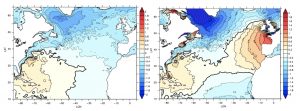REDUCING NUMERICAL MIXING RESULTING FROM APPLYING TIDES EXPLICITLY IN A GLOBAL OCEAN MODEL
PI and organization: A. Megann (NOC)
Co-Is: M. Luneva (NOC)
Abstract: Tidal forcing is proposed to be added explicitly to a global, eddy-permitting NEMO ocean model configuration. This replaces a parameterised tidal mixing scheme, and adds explicit representation of tidal currents, offering the potential advantages of a more realistic simulation of short-period circulation, as well as including a more physical mechanism for mixing in the deep ocean and shelf seas. However, the large vertical velocities characteristic of the barotropic tide, and especially of the internal tide, have been shown in other studies to lead to substantial numerical mixing in models with this resolution, with effective diffusivities up to ten times the diffusivity applied by the mixing scheme, and hence to unrealistic modifications to water masses in and below the thermocline. We therefore propose to subsequently add the “z-tilde” modification to the vertical coordinate, which is has been shown to reduce the spurious numerical mixing from waves with periods characteristic of tides. An established diagnostic method based on watermass transformations will be used to estimate the numerical mixing in four experiments: control; with tides; with z-tilde; and with tides and z-tilde, alongside further diagnostics of model temperature and salinity drifts, ocean and shelf sea circulations, and cross-shelf transports.
Project highlight at mid-term:
A global ocean model has been set up under the RENUMERATE project at the National Oceanography Centre, Southampton, closely related to the ocean component of the climate models the UK is submitting for the CMIP6 project (the model comparison part of the IPCC Sixth Assessment), but with tidal forcing applied. The left-hand panel shows a snapshot of the sea surface elevation in the North Atlantic without tides: the sea surface height is dominated by the differences between the wind-forced subtropical and subpolar gyres, with the finer-scale features corresponding to ocean eddies, particularly around the North Atlantic Current. The right-hand panel shows the same fields at the same time of the model experiment, but with tides: the large-scale tidal anomalies are seen to be superposed over those of the gyres, along with more local resonances of around the British Isles, the Bay of Fundy and the Gulf of St Lawrence, regions known in the real world for their considerable tidal range.



